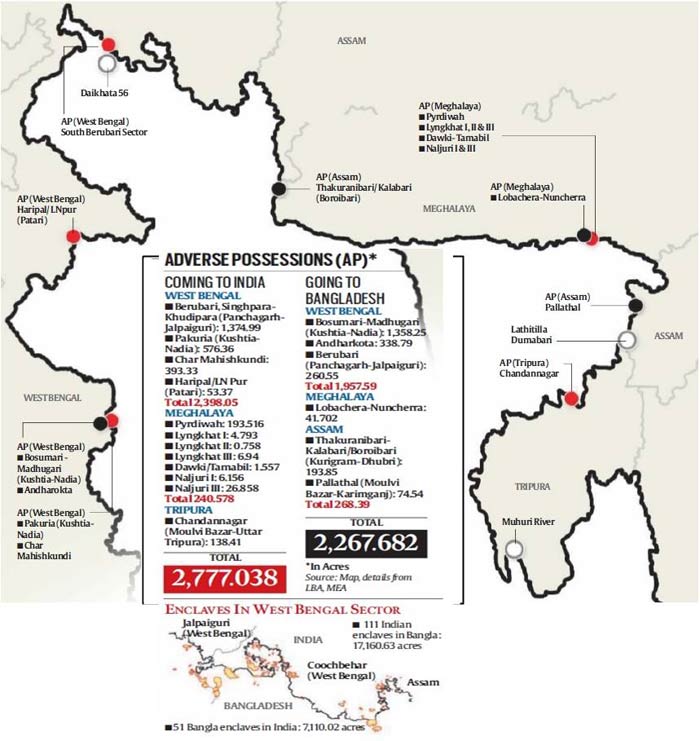
Guwahati Assam (BBN)-The India-Bangladesh LBA deal is described by The Indian Express and what led to the cabinet clearing the bill to operationalise the Land Boundary Agreement with Bangladesh.
Territories in Assam are now part of the agreement along with those in West Bengal, Tripura and Meghalaya and this is the key step forward, the report added.
An earlier plan to exclude Assam-the result of resistance from the BJP’s Assam unit-has now been dropped.
Assam’s Congress Chief Minister Tarun Gogoi had written to Prime Minister Narendra Modi asking him to set aside politics and include Assam in the deal.
What happens now?
Including Assam gets the Congress on board, and improves chances of the bill going through.
The bill comes in Rajya Sabha on Wednesday, where an earlier bill (excluding Assam) has been pending since December 2013.
Mamata Banerjee said on Tuesday that the Trinamool supports the agreement “because the people are in favour of it”.
The constitutional amendment bill will require ratification by at least 50 per cent of state legislatures as well.
What is the genesis of the Land Boundary dispute?
India and Bangladesh have a 4,096.7-km land boundary. The boundary (with erstwhile East Pakistan) was determined by the Radcliffe Award of 1947. Disputes arose out of provisions of the award.

What was the LBA of 1974?
It was signed on May 16, 1974 to solve the problems in the complex border demarcation.
Bangladesh ratified the agreement, but India didn’t, because it involved seceding territory, and indicating those areas on the ground.
Under the 1974 agreement, India would retain half of Berubari Union No. 12, and Bangladesh would keep the Dahagram and Angarpota enclaves.
India would lease in perpetuity to Bangladesh the so-called Tin Bigha Corridor” to connect Dahagram and Angarpota to the Bangla mainland.
The 1974 LBA was implemented in full-even though India did not ratify it-except for three issues related to undemarcated land boundary of approximately 6.1 km in three sectors: Daikhata-56 (West Bengal), Muhuri River-Belonia (Tripura) and Lathitila-Dumabari (Assam); exchange of enclaves; and adverse possessions.

What is the issue of enclaves?
The flawed partition left 111 Indian enclaves in Bangladesh (17,160.63 acres) and 51 Bangladeshi enclaves in India (7,110.02 acres).
Their inhabitants do not enjoy full legal rights as citizens of either country, or facilities like electricity, schools and healthcare.
Law and order agencies do not have proper access to these areas.
A joint headcount estimated the population in the enclaves to be around 51,549 (37,334 in Indian enclaves within Bangladesh).
An India-Bangla delegation that visited the enclaves in May 2007 found that residents on either side would rather be in the country where they had lived all their lives.
So, not much peoples’ movement is likely.
What about land “in adverse possession”?
Indian “adverse possession” refers to territory within Indian control, but which is legally part of Bangladesh.
Residents of these adverse possessions are Indian citizens. The same applies to Bangladeshi adverse possessions.
India is to receive 2,777.038 acres in respect of adverse possessions, and transfer 2,267.682 acres to Bangladesh.
The reality, though is that the area is already in Bangladeshi possession, and its handing over is merely a procedural acceptance of the de facto situation on the ground.
What happened after the LBA was signed in 2011?
The protocol addressed the unresolved issues of the 1974 LBA, without departing from it on any point other than the maintenance of status quo on adverse possessions.
How might the passage of the bill impact New Delhi-Dhaka relations?
Modi might visit Dhaka in June; India will look for transit through Bangladesh to connect with Northeast; counter-terror cooperation will get a fillip; Teesta water-sharing agreement will be the next on agenda; and Atal Bihari Vajpayee could get the top Bangla honour.